Understanding your cat's dietary needs is key to ensuring their health and happiness in the fascinating world of feline nutrition. Cats, famously picky eaters, need a diet that precisely caters to their distinct nutritional requirements. Being obligate carnivores, their dietary needs differ significantly from humans and dogs. Their meals should focus on high-quality animal proteins, vital fatty acids, and certain vitamins and minerals necessary for their well-being.
In this blog post, we will dive into the fundamental aspects of a cat's diet. Whether you're a new cat owner, your cat dislikes dry food, or looking to make your own cat food, this guide will help enhance your understanding and appreciation of what goes into keeping your beloved pet thriving.
Types of Commercial Cat Food
Commercial cat food is available in various types, each crafted to meet the distinct nutritional requirements of cats at various life stages and with diverse dietary needs. Here are the main types:
Dry Cat Food (Kibble)
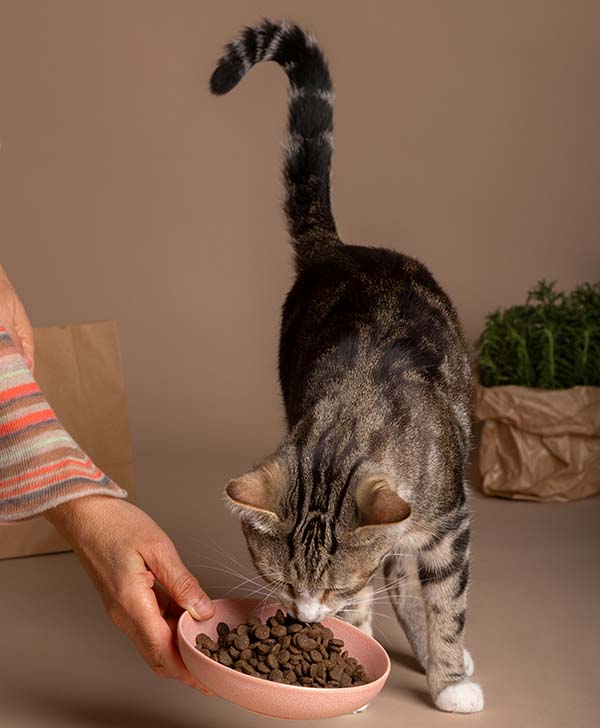
Image by Freepik
This is the most common commercial cat food type, known for its convenience, cost-effectiveness, and extended shelf life. Typically, dry food comprises a mixture of meat, grains, and vegetables, providing a balanced diet. It's lower in moisture content (about 10%) and can help keep teeth clean by reducing plaque buildup. However, dry cat food is less palatable than wet canned food and can lead to obesity, diabetes, and urinary tract blockage in indoor cats.
Wet Cat Food (Canned)
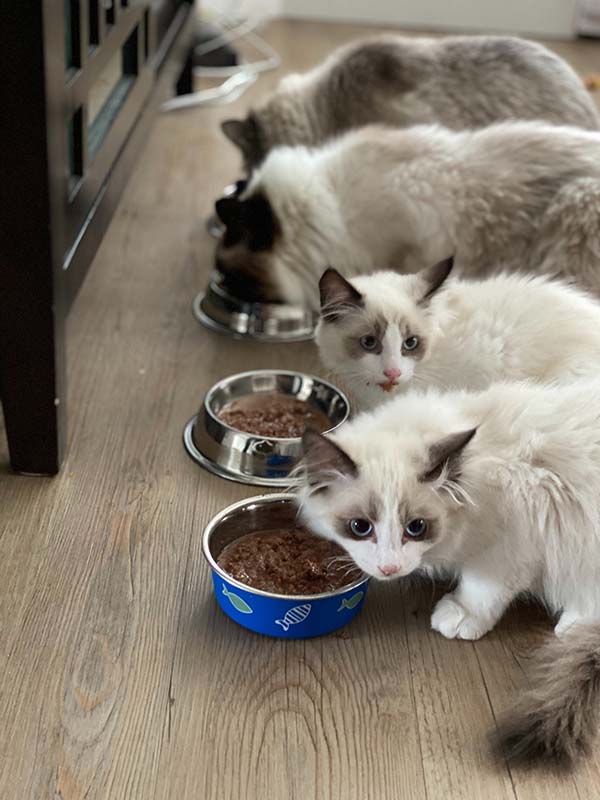
Canned cat food is higher in moisture content (about 70-80%) and is often preferred by cats due to its taste and texture. It is suitable for cats who may not consume sufficient water or those experiencing urinary tract issues. Wet food generally contains more meat and fewer carbohydrates than dry food, making it a good choice for weight management.
Semi-Moist Cat Food
This type has a moisture content between dry and wet food, usually around 35%. It's often more palatable than dry food but less so than wet food. Semi-moist food is not as common and can contain more artificial colors and preservatives.
What do cats eat
Meat
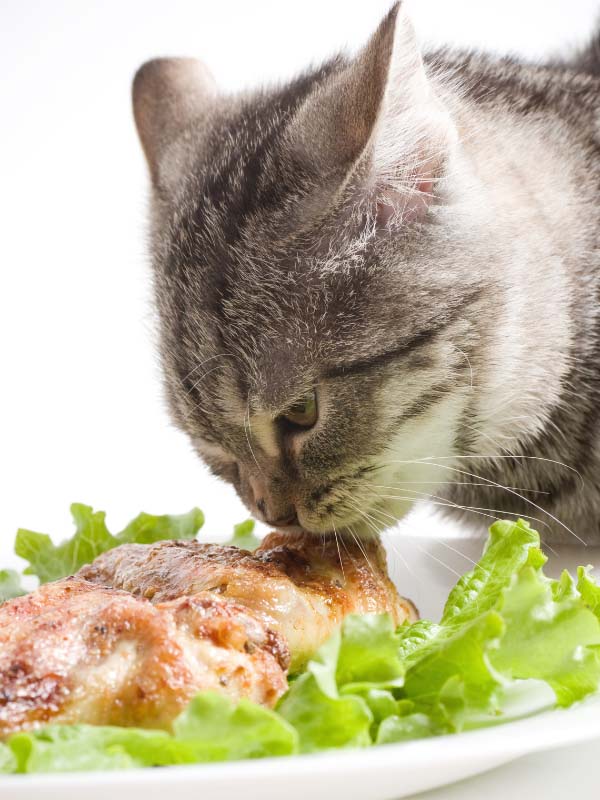
Felines, being obligate carnivores, flourish on a diet abundant in animal protein. Different types of meats offer various nutritional benefits essential for a cat's health. Here's a breakdown of common meats in a cat's diet, their benefits, and general feeding guidelines.
Chicken: One of the most popular proteins, chicken is a lean protein source that's relatively low in fat. Most cats prefer it, and it provides essential amino acids and is gentle on the stomach, making it ideal for cats, including those with sensitive digestion.
Turkey: Much like chicken, turkey serves as another lean protein source. It also contains essential nutrients such as taurine, which is crucial for cats' heart and eye health.
Beef: Beef is a richer protein source and provides many B vitamins, iron, and essential fatty acids. While beneficial for energy and overall health, it should be provided in moderation due to its higher fat content.
Fish: Fish, particularly salmon and tuna, are excellent sources of omega-3 fatty acids, which are vital for a cat's skin and coat health. However, fish should be fed sparingly as overconsumption can lead to certain vitamins and mineral deficiencies.
Lamb: Lamb is another excellent source of protein, frequently incorporated into hypoallergenic diets for cats with food sensitivities. It's rich in iron and can be a novel protein for cats with allergies to more common meats.
Egg: Including eggs in a cat's diet can be a nutritious addition, as eggs are an excellent source of protein, fatty acids, and vitamins. However, eggs should always be cooked (boiled or scrambled) to avoid the risk of salmonella or E. coli.
Adult, healthy cats typically require about 2-4 ounces of cooked meat per day, depending on their size, age, and activity level. This should be adjusted if the cat also consumes commercial cat food. Kittens and pregnant or nursing cats will have higher protein requirements.
It's important to ensure the meat is cooked without harmful seasonings or onions/garlic and served in appropriate-sized pieces to prevent choking. Always seek advice from a veterinarian to customize the diet according to your cat's specific nutritional requirements and health conditions. Remember, a balanced diet is crucial, and meat alone won't provide all the necessary nutrients, so it should be part of a comprehensive feeding plan.
Organ Meats
Organ meats are a crucial component of a cat's diet, offering dense nutritional benefits vital for their overall health. Here's an overview of common organ meats in a cat's diet, their benefits, and general feeding recommendations:
Liver: The liver is one of the most nutrient-rich organ meats. It is an excellent source of vitamin A, a vital nutrient essential for vision, growth, and immune function. The liver also provides a good amount of iron and B vitamins. Nevertheless, it should be administered in moderation, as excess vitamin A can be toxic to cats.
Heart: The heart is a great source of taurine, an amino acid critical for heart health, vision, and reproduction in cats. It is also abundant in protein and B vitamins, notably B12.
Kidneys: Kidneys are rich in protein and contain essential nutrients such as iron, phosphorus, and B vitamins. They benefit urinary health and are often included in renal diets for cats with kidney issues.
Gizzards (stomach): Gizzards are a good source of protein and provide a natural, rough texture that helps in dental health. They also contain zinc and vitamin B12.
Spleen: While less commonly used, the spleen is a good source of iron, vitamin B12, and other essential minerals.
Organ meats should not make up more than 5-10% of a cat's total dietary intake due to their high concentration of vitamins and minerals. A balance is key; too much can lead to vitamin imbalances, while too little can lead to deficiencies.
For a typical adult cat, a small portion (about a teaspoon to a tablespoon) of organ meat daily or a few times a week is sufficient, depending on their size, age, and health condition. Always serve organ meats cooked and unseasoned to ensure safety and digestibility.
Fruits
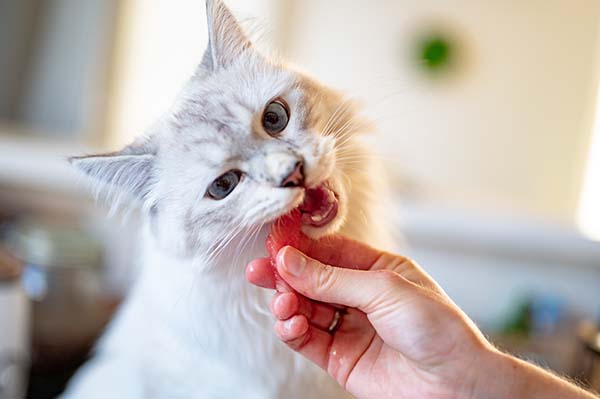
Although cats are obligate carnivores and primarily thrive on a meat-based diet, some fruits can be safely offered as occasional treats. Here's a list of cat-safe fruits, their benefits, and general guidelines on how much to feed:
Apples: A good source of vitamins A and C and fiber. They should be provided in small, bite-sized pieces without the seeds or core.
Blueberries: Abundant in antioxidants and vitamins C and K, blueberries can contribute to a cat's immune system and overall health. Additionally, they are low in calories.
Watermelon: Hydrating and low in calories, watermelon offers vitamins A, B6, and C. Ensure it is seedless and provided in small amounts.
Bananas: Rich in potassium and soluble fiber, bananas can serve as a healthy treat. Nevertheless, owing to their high sugar content, they should be given sparingly.
Cantaloupe: This melon is a good source of beta-carotene, which converts to vitamin A, and is also rich in antioxidants. Offer in small, manageable pieces.
Strawberries: Strawberries contain antioxidants, fiber, and vitamin C. They can be an occasional treat in small quantities.
Pumpkin: Plain, cooked pumpkin (not pumpkin pie filling) is fiber-rich and can aid digestion. It also serves as a good source of vitamin A and antioxidants.
When incorporating fruits into a cat's diet, it's crucial to do so gradually and in moderation. Fruits should only make up a small portion of their diet, as high-quality animal proteins best meet their primary nutritional needs. A general guideline is to ensure that treats, including fruit, constitute no more than 10% of a cat's daily caloric intake.
Always remove any seeds, pits, stems, and leaves that can be harmful, and cut fruits into appropriate bite-sized pieces to prevent choking. It is also crucial to note that some fruits, such as grapes, raisins, and citrus fruits, are toxic to cats and should be avoided entirely.
Vegetables
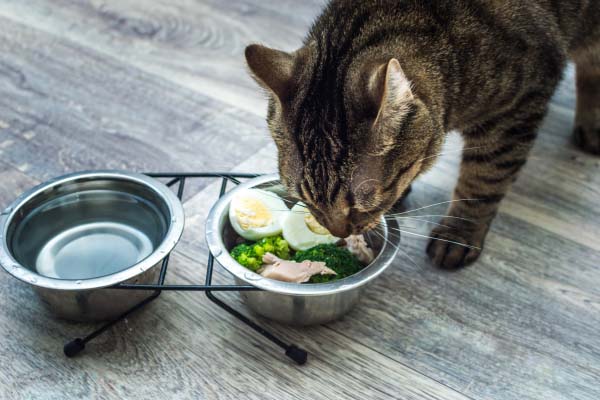
Cats can occasionally enjoy certain vegetables as part of a balanced diet. Here's a list of cat-safe vegetables, their benefits, and guidelines for feeding:
Carrots: Rich in beta-carotene, which converts to vitamin A in the body, carrots support eye health and the immune system. It is advisable to cook them and cut them into small, manageable pieces.
Green Beans: A great low-calorie treat, green beans are high in fiber and contain essential vitamins like vitamin K and manganese. They can serve as a suitable snack for cats, particularly those requiring weight management.
Pumpkin: Plain, cooked pumpkin is rich in fiber, promotes digestion, and is a good source of vitamin A and antioxidants. It's beneficial for cats with digestive issues.
Broccoli: Rich in fiber and vitamin C, broccoli can be a healthy snack when steamed and given in small quantities. It's good for cats who enjoy chewing on plants.
Peas: Often found in commercial cat foods, peas are a good source of protein and fiber, as well as vitamins A, K, and B vitamins. They can be offered cooked and plain.
Spinach: Abundant in vitamins A, C, and K, as well as iron and calcium; spinach can be beneficial but should be avoided if your cat has a history of calcium oxalate bladder stones.
Zucchini: This is a low-calorie vegetable high in fiber and potassium and can be a healthy treat for cats.
Vegetables should be introduced gradually and constitute only a small portion of a cat's diet. Treats, including vegetables, should not exceed 10% of a cat's total daily caloric intake. Always cook vegetables without added oils, butter, or seasoning, and chop them into small, manageable pieces to prevent choking and aid digestion.
Certain vegetables, such as onions and garlic, are toxic to cats and should always be avoided. As with any dietary changes or introduction of new foods, it's advisable to consult with a veterinarian to ensure they're appropriate for your cat's specific health needs and dietary requirements.
Grains
Cats can eat certain grains, although their diets should be predominantly meat-based due to their obligate carnivorous nature. Here are some grains that are generally safe for cats, along with their benefits:
Rice: Easily digestible and non-allergenic, rice can be a good option for cats with sensitive stomachs. It serves as a source of energy and can aid in binding stools in cases of diarrhea.
Oats: Oats are a source of protein and soluble fiber, which can aid digestion. They also contain vitamins and minerals beneficial for a cat's health, such as iron and B vitamins.
Barley: Abundant in fiber, barley can support a healthy digestive system. It is also a good energy source and contains essential nutrients like selenium and copper.
Wheat: While some cats may be allergic to wheat, it can be a good energy source and fiber for others. However, it should be given in moderation.
In terms of quantity, grains should only make up a small portion of a cat's diet, as animal proteins best meet their primary nutritional needs. Treats, including grains, should not exceed 10% of a cat's daily caloric intake. Grains should be cooked and served plain (without butter, salt, or seasoning) to ensure they are safe for consumption.
What Human Foods Cats Should Never Eat
Various human foods should never be offered to cats due to their potential toxicity or adverse effects. It's crucial to keep these foods away from cats to ensure their safety and well-being:
Onions and Garlic: All onion family members (including shallots, scallions, and chives) are toxic to cats. These foods can cause gastrointestinal upset and lead to red blood cell damage and anemia.
Chocolate: Chocolate contains theobromine and caffeine, both of which are toxic to cats. Dark chocolate and unsweetened baking chocolate pose particular dangers.
Grapes and Raisins: Even in small amounts, grapes and raisins can induce kidney failure in cats.
Alcohol: Any form of alcohol can be harmful to cats, leading to intoxication, coma, and potentially death.
Caffeine: Coffee, tea, energy drinks, and other beverages containing caffeine can harm cats. Signs of caffeine poisoning in cats may include restlessness, rapid breathing, heart palpitations, and muscle tremors.
Xylitol: This artificial sweetener, found in many sugar-free products like gum and candy, can cause a rapid insulin release in cats, leading to hypoglycemia and liver failure.
Dairy Products: Numerous cats are lactose intolerant and unable to process dairy products, which can result in digestive upset.
Raw Meat, Eggs, and Bones: Raw meat and raw eggs can harbor harmful bacteria such as Salmonella and E. coli, while bones pose risks of choking or gastrointestinal obstruction.
Fatty Foods: Excessively fatty foods can induce gastrointestinal upset and pancreatitis in cats.
Yeast Dough: Yeast dough can expand in a cat's stomach, leading to pain and potential blockages. Moreover, as yeast ferments, it can generate alcohol, which is toxic to cats.
